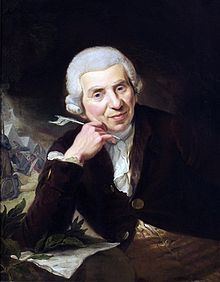Name Johann Ludwig | Role Poet | |
 | ||
Similar People Joseph Haydn, Wolfgang Amadeus Mozart, Ludwig van Beethoven, Alban Berg | ||
Johann wilhelm ludwig gleim anakreon lyrik elsterslesehohle
Johann Wilhelm Ludwig Gleim (2 April 1719 – 18 February 1803) was a German poet, commonly associated with the Enlightenment movement.
Contents
- Johann wilhelm ludwig gleim anakreon lyrik elsterslesehohle
- Lyrik fur alle folge 9 johann wilhelm ludwig gleim
- Life
- Work
- Gleimhaus
- Temple of Friendship
- Gleim Prize
- References
Lyrik fur alle folge 9 johann wilhelm ludwig gleim
Life
Gleim was born at the small town of Ermsleben in the Principality of Halberstadt, then part of Prussia. His father, a tax collector, and his mother died early. He attended school in Wernigerode and from 1738 onwards studied law at the University of Halle, where he established a circle of young poets together with his friends Johann Uz and Johann Nikolaus Götz.
Having obtained his final degree, he worked as a tutor in Berlin, where in 1743–44 he became secretary to the Hohenzollern prince Frederick William of Brandenburg-Schwedt. Gleim accompanied his employer in the Second Silesian War and made the acquaintance of Ewald Christian von Kleist, whose devoted friend he became. When the prince was killed during the Prussian siege of Prague, Gleim became secretary to Prince Leopold of Anhalt-Dessau; but he soon gave up his position, not being able to bear the roughness of the "Old Dessauer".
In 1747, after again living in Berlin for a few years, he was appointed secretary of the Halberstadt Cathedral chapter. From 1756 he also served as a canon at the nearby Walbeck monastery. He became known as "Father Gleim" throughout all literary Germany on account of his kind-hearted though inconsiderate and undiscriminating patronage alike of the poets and poetasters of the period.
He died at the age of 83 in Halberstadt, then completely blind, but a wealthy and respected citizen. He was buried in his garden on the Holtemme river.
Work
Gleim's Collected Works appeared in 7 volumes in the 1811–13; a reprint of the Lieder eines Grenadiers was published by A. Sauer in 1882. A good selection of Gleim's poetry will be found in Franz Muncker's Anakreontiker und preussisch-patriotische Lyriker (1894) and Friedrich Wilhelm Körte's Gleims Leben aus seinen Briefen und Schriften (1811). His correspondence with Johann Jakob Wilhelm Heinse was published in 2 volumes (1894/1896), with Johann Uz (1889), in both cases edited by C. Schüddekopf.
Influenced by the aesthetic writings of Alexander Gottlieb Baumgarten and Georg Friedrich Meier, both lecturers at the Halle university, Gleim attempted to cultivate the Anacreontic tradition of short lyrical pieces of an easy kind. He wrote a large number of imitations of Anacreon, Horace and the minnesingers, a didactic poem inspired from his reading in the Quran entitled Halladat oder das rote Buch (1774), and collections of fables and romances. Many of his poems were set to music: C.P.E. Bach, Beethoven, Joseph Haydn, Reichardt, Schubart, and Spohr all set some of his Anacreontic poems.
Of higher merit are his Preussische Kriegslieder von einem Grenadier (1758). Inspired by the Prussian campaigns of King Frederick the Great in the Seven Years' War, they are often distinguished by genuine feeling and vigorous force of expression. They are also noteworthy as being the first of that long series of noble political songs in which later German literature is so rich. Written in a Chevy Chase tune and first set to music by Christian Gottfried Krause, the Kriegslieder attracted wide attention in a poetry collection edited by Lessing in 1758, and later were also set by Telemann and Schubart.
Compared to this collection, Gleim's other writings, though also very popular in his day, were for the most part conosidered commonplace in thought and expression by later generations. Only recently, a revaluation of his work in the context of 18th century literary history has taken place. Significant contributions of Gleim include the establishment of German as literary language and his promotion of young talents such as Heinse, Johann Heinrich Voss, Seume, or Jean Paul.
Gleimhaus
After Gleim's death in Halberstadt, his personal effects were carefully looked after by his great-nephew, Friedrich Wilhelm Körte (1776–1846). In 1862, Gleim's library of 12,000 books (including 50 incunabula) and the huge collection of letters, manuscripts and documents in his estate were used as the kernel of a museums of 18th century literary life in Halberstadt and beyond. Augmented by the collection of the local poet Christian Friedrich Bernhard Augustin (1771–1856) and still in operation, the Gleimhaus is one of the oldest literary museums in Germany.
Temple of Friendship
At his house near Halberstadt Cathedral, Gleim created a "Temple of Friendship" (Freundschaftstempel), regular meetings of poets and intellectuals including Johann Georg Jacobi, Heinse, Christoph August Tiedge, Leopold Friedrich Günther von Goeckingk and many others. Two rooms he devoted to a collection of portraits of friends, which numbered more than 120 by the time of his death. Artists commissioned by Gleim included Anton Graff, various members of the Tischbein family, Bernhard Rode and Benjamin Calau.
Gleim Prize
The Gleim Prize for Literature (Gleim-Literaturpreis), awarded for outstanding non-fiction on the subject of 18th century literature, was established in 1995.
